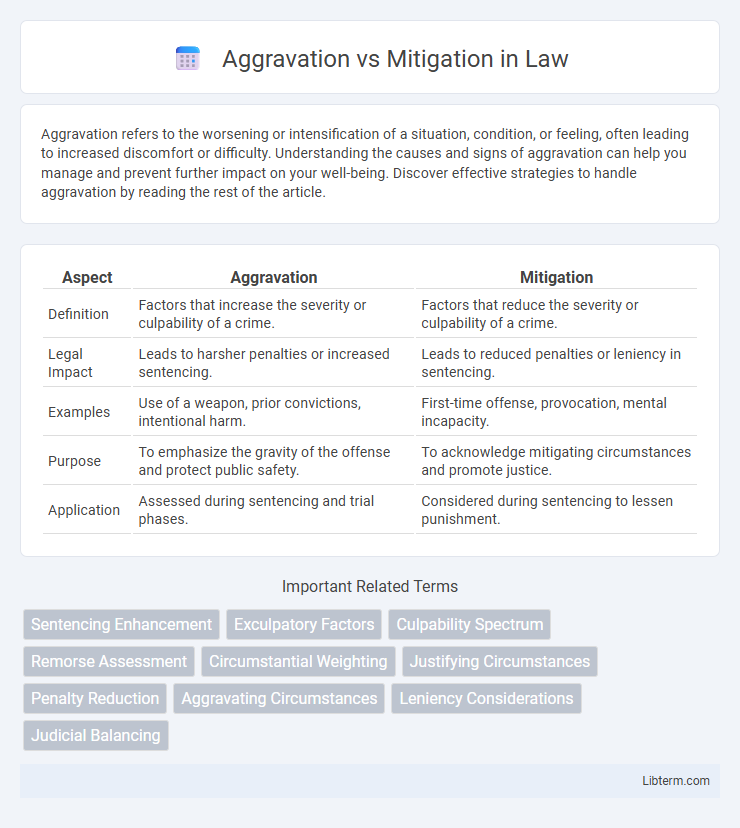Aggravation refers to the worsening or intensification of a situation, condition, or feeling, often leading to increased discomfort or difficulty. Understanding the causes and signs of aggravation can help you manage and prevent further impact on your well-being. Discover effective strategies to handle aggravation by reading the rest of the article.
Table of Comparison
| Aspect | Aggravation | Mitigation |
|---|---|---|
| Definition | Factors that increase the severity or culpability of a crime. | Factors that reduce the severity or culpability of a crime. |
| Legal Impact | Leads to harsher penalties or increased sentencing. | Leads to reduced penalties or leniency in sentencing. |
| Examples | Use of a weapon, prior convictions, intentional harm. | First-time offense, provocation, mental incapacity. |
| Purpose | To emphasize the gravity of the offense and protect public safety. | To acknowledge mitigating circumstances and promote justice. |
| Application | Assessed during sentencing and trial phases. | Considered during sentencing to lessen punishment. |
Defining Aggravation and Mitigation
Aggravation refers to factors or actions that increase the severity or harmful impact of a situation, event, or condition, often leading to worsened outcomes or higher liability. Mitigation involves measures or strategies implemented to reduce the negative effects or risks associated with a particular circumstance, aiming to minimize damage or liability. Understanding the distinction between aggravation and mitigation is crucial in legal, environmental, and risk management contexts for effective decision-making and accountability.
Legal Contexts: Where Aggravation and Mitigation Matter
Aggravation and mitigation are crucial concepts in legal contexts, particularly during sentencing in criminal cases. Aggravation refers to factors or circumstances that increase the severity or culpability of a crime, such as prior convictions or use of a weapon, leading to harsher penalties. Mitigation involves presenting evidence or arguments that reduce the defendant's blameworthiness, including lack of intent, mental illness, or cooperation with authorities, which can result in lighter sentences or alternative punishments.
Key Differences Between Aggravating and Mitigating Factors
Aggravating factors increase the severity or culpability of a crime, often leading to harsher penalties, while mitigating factors decrease the defendant's blameworthiness, potentially reducing sentences. Key differences include the nature of the circumstances: aggravating factors can involve prior criminal history, use of violence, or vulnerability of the victim, whereas mitigating factors may consist of lack of intent, mental illness, or cooperation with authorities. Courts analyze these opposing elements to balance justice, influencing sentencing outcomes based on the weight of each factor.
Common Examples of Aggravating Circumstances
Common examples of aggravating circumstances include prior criminal history, use of a weapon during the offense, and the commission of a crime with particular cruelty or deception. Factors such as targeting vulnerable victims, committing offenses for financial gain, or violating a position of trust also commonly intensify legal penalties. Courts consider these aggravating elements to increase sentences as they indicate higher culpability or danger to society.
Typical Mitigating Factors in Legal Cases
Typical mitigating factors in legal cases include the defendant's lack of prior criminal history, demonstrated remorse, and cooperation with law enforcement. Mental health issues, such as cognitive impairments or emotional disturbances, often influence sentencing by reducing perceived culpability. These factors collectively contribute to a more lenient punishment by highlighting circumstances that lessen the severity of the offense.
The Role of Aggravation in Sentencing Decisions
Aggravation plays a critical role in sentencing decisions by highlighting factors that increase the severity or culpability of a crime, such as prior convictions, use of a weapon, or the vulnerability of the victim. Courts consider aggravating circumstances to impose harsher penalties, reflecting the increased harm or risk associated with the offense. This approach ensures that sentences align more closely with the gravity of the crime and promote justice by deterring repeat offenses.
How Mitigation Influences Judicial Outcomes
Mitigation significantly influences judicial outcomes by presenting factors that reduce the defendant's culpability, often resulting in lighter sentences or alternative penalties. Courts consider mitigating evidence such as lack of prior criminal history, mental health issues, or remorse demonstrated by the defendant to balance the impact of aggravating factors. The presence of strong mitigation can sway judicial discretion toward rehabilitation-focused rulings rather than purely punitive measures.
Aggravation vs Mitigation: Case Studies
Case studies analyzing aggravation versus mitigation reveal significant differences in legal outcomes, with aggravation factors such as prior offenses or intent intensifying penalties, while mitigation elements like remorse or lack of criminal history lead to reduced sentences. Research indicates that courts weigh aggravating circumstances more heavily in violent crimes, often resulting in harsher punishments, whereas mitigation is more influential in property crime cases. Statistical data from judiciary reports confirm that effective presentation of mitigation can decrease sentencing length by up to 30%, highlighting its critical role in legal defense strategies.
The Importance of Proper Legal Representation
Proper legal representation is crucial in cases involving aggravation versus mitigation as it directly influences sentencing outcomes by effectively presenting evidence that can either increase or decrease penalties. Skilled attorneys analyze case details to identify aggravating factors like prior offenses or the severity of the crime, as well as mitigating circumstances such as mental health issues or lack of intent. This balanced approach ensures the court receives a comprehensive understanding, promoting fair and just legal consequences.
Balancing Justice: The Interplay Between Aggravation and Mitigation
Balancing justice involves carefully weighing aggravation factors, such as prior offenses or the severity of a crime, against mitigation elements like remorse or cooperation with authorities. The interplay between aggravation and mitigation shapes sentencing decisions, ensuring punishment is proportional and fair. This equilibrium promotes a justice system that acknowledges both the gravity of offenses and the potential for rehabilitation.
Aggravation Infographic

 libterm.com
libterm.com